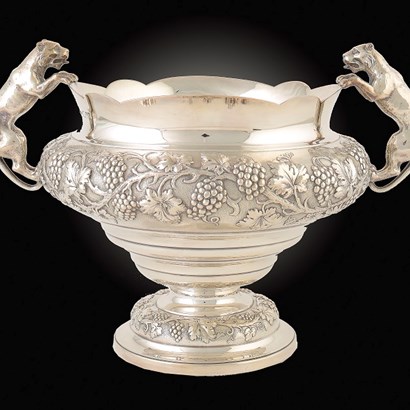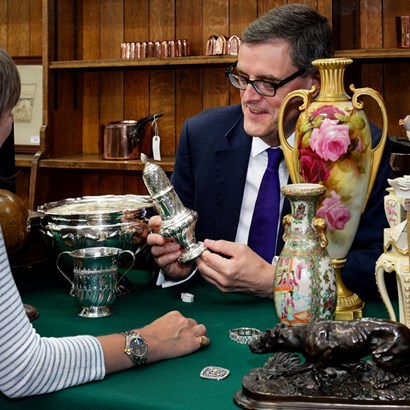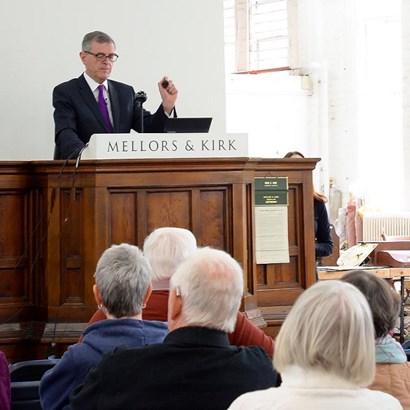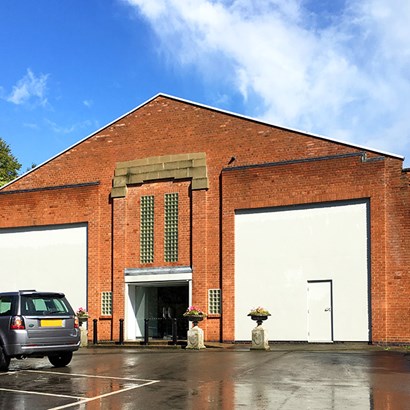Auction Insights
Jamaican Cabinet
In a week when slavery has been in the headlines Nigel Kirk looks at two Jamaican objects from that darkest chapter in the island’s history.
The most intriguing of all antiques can easily be overlooked because at first sight they appear unremarkable. Antique furniture which is now often called by the appellation ‘brown’, is all the more likely to slip through unnoticed. These are known, not surprisingly as ‘sleepers’ or items that are picked up for a song from auctions and dealers and re-sold for a fortune. Researching them can be highly rewarding but also frustrating.
Few knowledgeable furniture historians would think that this small and neat mahogany writing cabinet was made outside the British Isles, let alone over 7,000 miles away in the Caribbean. It looks much like other Regency period (early 19th century) furniture that emerged from the workshops of most better British cabinet makers of the period. Some experts might suggest that it is ‘provincial’ or perhaps of Irish or Scottish origin on account of its unusual, one off design. Others might propose that it was made in one of the British colonies, but which? What is only apparent from inspection is its breath-taking quality, with a host of refinements including the most delicately cut dovetailed joints and, even better, someone at the time chose to label it, presumably because they too were so impressed with it. The unknown owner has written on a sheet of ordinary writing paper found pasted to the underside of one of the drawers “This case was made by John Soulette of King St Kingston Jamaica, a brown man, and native of that island Jamaica, 22nd March 1828”
For 300 years the island was a British colony. The colossal wealth that stemmed from Jamaican sugar plantations depended wholly on the largely African slave labour which had reached its peak by the early 19th century when it was abolished.
Many aristocratic or well off British families had connections with the island’s sugar plantations or the slave trade, whether directly or indirectly. Those who visited Jamaica for any length of time would have supplemented their imported belongings from home with locally made items, such as furniture and silver. So what is known of John Soulette? From research in the island’s archives and others in London he is known to have supplied unspecified goods to Samuel Moulton Brown in 1838.
The marriage of another John Soulette, (born c1817) in or before January 1844 is recorded in the register of the Roman Catholic Church in Kingston, as is the birth of a daughter, Henrietta Margaurite in 1842. He, or perhaps his son, was a well known watchmaker and jeweller, with a shop on Amen Corner, Kingston by the late 19th century.
The leading Jamaican cabinet makers in the 19th century, Ralph Turnbull & Sons of Kingston was established sometime between 1815-19 by Ralph Turnbull (d1788) who arrived from Scotland. By 1823 Turnbull’s two brothers Cuthbert and Thomas had established independent workshops. That Soulette was in someway connected with at least one or more of the Turnbulls is probable. The only other object known to be made by him, a Jamaican specimen wood box, also made and labelled by John Soulette was sold at an auction in 2013.
It should not be assumed that the word ‘brown’ in 1828 was intended to be pejorative. It is descriptive and could imply that Soulette was of mixed heritage.
The cabinet is double sided with an arrangement of doors and/or drawers to both the back and front and was meant to be freestanding, rather than placed against the wall of a room. The principal wood is mahogany, the interior fittings are in luxurious golden, West Indian satinwood and the drawer linings are of cedar. Exactly why it should be centred by a plush lined cupboard enclosed by a glazed door is unknown. Perhaps it was to hold a silver trophy or maybe keep the owner’s plumed helmet.
With an area of one quarter the size of the East Midlands, Jamaica’s population by the early 19th century was around 320,000. Most of these were slaves or their descendants. Ten percent of the population lived at Kingston, the island’s capital which was then fast developing. The first newspaper to be published on the island, horticultural and agricultural societies, railways, colleges and other institutions all appeared during the first half of 19th century. Interestingly, Kingston’s racecourse was founded as early as 1783, before practically anything else and a sure sign of the British obsession with the sport of kings.
The Soulette cabinet which has survived in exceptional, original condition will be sold at The Auction House in March on behalf of a local gentleman who has owned it for many years. The estimate is £8,000-10,000.
By coincidence, another memento of British upper class society in Jamaica of the same period is a beautiful gold snuff box which was also made in the island, perhaps also by the talented Mr Soulette, that was sold by Mellors & Kirk two years ago. It was presented as a gift from one sugar plantation owner on the island, William Shand (1776-1845) by Dr Kean Brown Osborn (1770-1852) whose own two sugar plantations were on Antigua. In 1845 Osborn was one of the slave owners who received generous compensation from the British government when slavery was abolished, an interesting but disturbing fact I discovered from the UCL’s fascinating website ‘Legacies of British Salve Ownership’.
< Back to Auction Insights



